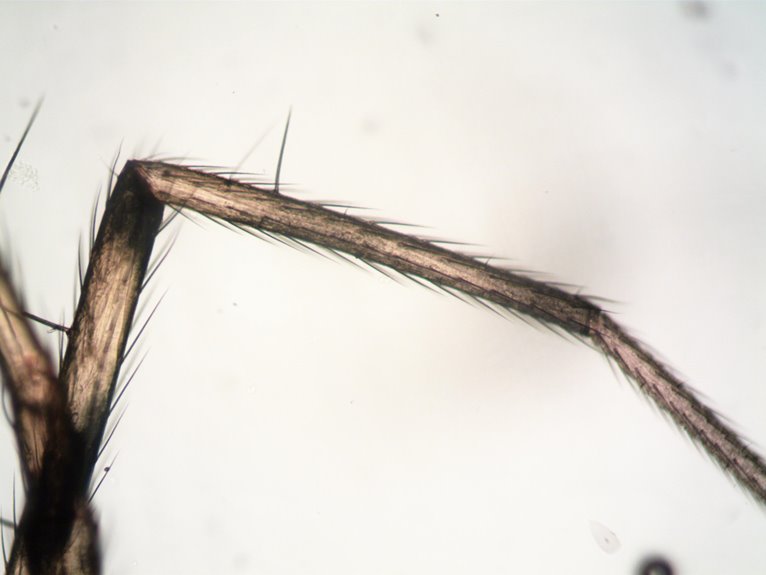If you need fibers that withstand extreme heat with flexibility, meta-aramids are your best bet—they’re great for protective clothing and insulation. But if your project demands exceptional strength and durability, para-aramids excel in impact resistance and tensile strength, perfect for body armor or ropes. Each fiber’s chemical structure influences its performance, so choosing depends on whether heat resistance or toughness matters more. Discover how these differences match your specific needs to make the right choice.
Table of Contents
Key Takeaways
- Meta-aramids offer superior heat resistance and flexibility, ideal for protective clothing and high-temperature environments.
- Para-aramids provide exceptional tensile strength and durability, perfect for impact-resistant gear like body armor and ropes.
- Choose meta-aramids for applications requiring comfort and chemical resistance in extreme heat.
- Select para-aramids when maximum strength, stiffness, and resistance to stretching are critical.
- Consider cost and environmental exposure, as para-aramids are pricier but more durable, while meta-aramids are more economical with better heat and chemical resistance.
What Are Meta-Aramids?
Meta-aramids are a type of synthetic fiber known for their excellent heat resistance and durability. When you use meta-aramids, you benefit from fibers that can withstand high temperatures without melting or catching fire, making them ideal for protective clothing and insulation.
They also offer good chemical resistance and maintain strength under stress. You’ll find meta-aramids commonly in firefighter suits, electrical insulation, and aerospace components. Unlike other fibers, they don’t degrade quickly when exposed to heat or harsh environments.
If your project requires materials that can handle intense heat and provide reliable performance over time, meta-aramids are a smart choice. They balance strength and flexibility, ensuring comfort and safety in demanding applications without sacrificing durability.
What Are Para-Aramids?
Para-aramids are high-performance synthetic fibers prized for their exceptional strength and durability. When you need materials that withstand extreme stress or impact, para-aramids are your go-to choice.
They’re commonly used in bulletproof vests, helmets, and aerospace components because they offer superior tensile strength and resistance to abrasion. Unlike some fibers that degrade under heat, para-aramids maintain integrity in high-temperature environments, making them reliable for protective gear.
You’ll also find them in ropes, cables, and tires where toughness is critical. If your project demands a fiber that combines lightweight properties with outstanding resilience, para-aramids fit the bill perfectly.
Their ability to absorb energy while staying strong makes them indispensable in safety and industrial applications.
Chemical Structure Differences Between Meta- and Para-Aramids
Although both fibers belong to the aramid family, their molecular arrangements set them apart in key ways.
In meta-aramids, the amide groups attach at the 1 and 3 positions on the benzene ring, which creates a kinked, less linear chain. This structure limits how closely the molecules can pack together, influencing the fiber’s heat resistance and flexibility.
Para-aramids, on the other hand, have amide groups attached at the 1 and 4 positions, forming a straight, rigid chain. This linear arrangement allows for tighter molecular packing, boosting strength and thermal stability.
When you choose between meta- and para-aramids, understanding these structural differences helps you match the fiber’s chemical properties to your specific needs—whether that’s durability, heat resistance, or flexibility.
Mechanical Properties and Strength Comparison
The differences in molecular structure directly influence how these fibers perform under stress.
When you compare meta-aramid and para-aramid, you’ll notice para-aramid offers superior tensile strength and stiffness. This means para-aramid fibers can handle higher loads and resist stretching better, making them ideal for applications requiring extreme durability, like ballistic protection or ropes.
On the other hand, meta-aramid provides excellent toughness and flexibility, so it’s better suited when you need impact resistance without sacrificing pliability.
If you need a fiber that balances strength and flexibility, meta-aramid might be your choice. However, if maximum strength and load-bearing capacity are critical, para-aramid will serve you better.
Understanding these mechanical differences helps you pick the right fiber for your specific application.
Thermal Resistance and Heat Stability
When you need materials that withstand high temperatures, understanding the thermal resistance and heat stability of meta-aramid and para-aramid is essential.
Meta-aramid fibers, like Nomex®, offer excellent thermal resistance, maintaining integrity up to around 370°C (700°F). They resist heat degradation and provide consistent protection against flames and sparks, making them reliable in high-heat environments.
Meta-aramid fibers like Nomex® withstand heat up to 370°C, offering reliable flame and spark protection.
Para-aramid fibers, such as Kevlar®, also handle heat well but start to degrade at slightly lower temperatures, near 400°C (752°F). However, they excel in heat stability under mechanical stress and retain strength longer under dynamic conditions.
When choosing between them, consider if you need superior heat endurance with stable mechanical performance (para-aramid) or robust heat resistance with good flame retardancy (meta-aramid) to suit your specific application.
Common Applications for Meta-Aramid Fibers
When you need reliable protective clothing, meta-aramid fibers are a top choice because they resist heat and flames.
You’ll also find them in electrical insulation, where safety and durability matter most.
Plus, meta-aramid is key in industrial safety gear, helping keep workers protected in tough environments.
Protective Clothing Uses
Although meta-aramid fibers aren’t as strong as para-aramids, you’ll find them widely used in protective clothing due to their excellent heat and flame resistance.
When you need gear that shields against high temperatures, like firefighter uniforms or industrial workwear, meta-aramids are a smart choice. They won’t melt or drip when exposed to flames, keeping you safer in hazardous environments.
You’ll also see meta-aramid fibers in welding jackets, gloves, and protective suits where consistent thermal protection matters.
Plus, these fibers maintain comfort and flexibility, so your clothing doesn’t restrict movement during demanding tasks.
If your job involves exposure to sparks, heat, or fire but doesn’t require the extreme strength of para-aramid, meta-aramid-based protective clothing offers reliable, durable protection.
Electrical Insulation Applications
Since meta-aramid fibers resist heat and electrical currents without degrading, they’re ideal for electrical insulation applications. When you need reliable, durable insulation, meta-aramid offers excellent performance.
Here are common uses you might consider:
- Insulation wraps for cables and wires, preventing short circuits.
- Protective sleeves for electrical components that endure high temperatures.
- Insulating mats used in electrical panels to avoid accidental contact.
- Heat-resistant tapes for securing and insulating electrical connections.
Choosing meta-aramid guarantees you get materials that maintain integrity under stress and heat, enhancing safety and longevity in electrical systems.
If you want dependable insulation that won’t break down quickly, meta-aramid is a smart choice.
Industrial Safety Gear
If you work in environments where heat and flame hazards are common, you’ll appreciate how meta-aramid fibers enhance industrial safety gear.
These fibers offer excellent thermal resistance and flame retardancy, making them ideal for protective clothing like firefighter suits, welding gloves, and industrial workwear.
Meta-aramid’s durability and resistance to abrasion guarantee that your gear remains reliable even under demanding conditions.
Unlike some materials, meta-aramid doesn’t melt or drip when exposed to high temperatures, providing an extra layer of safety.
Whether you need protection from sparks, heat, or flames, meta-aramid fibers help keep you safe without sacrificing comfort or flexibility.
Choosing gear made with meta-aramid means you’re investing in dependable protection tailored for tough industrial environments.
Common Applications for Para-Aramid Fibers
Para-aramid fibers excel in applications where high strength and durability are essential. If you need materials that withstand extreme conditions, para-aramid is a go-to choice.
You’ll find it in various industries due to its exceptional performance. Here are common applications where para-aramid fibers shine:
- Personal Protective Equipment (PPE): Helmets, gloves, and body armor use para-aramid for impact and cut resistance.
- Aerospace and Automotive: It reinforces composite materials in aircraft and race cars, enhancing safety and reducing weight.
- Ropes and Cables: Para-aramid’s strength makes it perfect for climbing ropes and marine cables.
- Electrical Insulation: Its heat resistance helps insulate wires and components in demanding environments.
When you need reliable, high-performance fibers, para-aramid often fits the bill perfectly.
Factors to Consider When Choosing Between Meta- and Para-Aramid
When you’re deciding between meta-aramid and para-aramid, you’ll want to weigh factors like strength, heat resistance, and flexibility.
Para-aramid offers superior tensile strength and durability, making it ideal for high-impact applications like body armor.
Meta-aramid, on the other hand, excels in heat and flame resistance, so it’s better suited for protective clothing in extreme temperatures.
Consider flexibility too—meta-aramid fibers are more pliable, which can enhance comfort in wearable gear.
Cost might also influence your choice; para-aramid tends to be pricier due to its advanced performance.
Finally, think about the environment where the fiber will be used. If exposure to chemicals or UV light is a concern, check each fiber’s resistance to guarantee long-term reliability.
Frequently Asked Questions
Are Meta- and Para-Aramids Recyclable?
You can recycle meta- and para-aramids, but it’s not common due to their complex chemical structures. You’ll often find them downcycled or repurposed instead of fully recycled into new fibers, so consider disposal options carefully.
How Do Meta-Aramids Perform in Moisture Resistance?
Oh, sure, because your clothes just love soaking up water, right? Meta-aramids actually resist moisture well, so you don’t have to worry about soggy, limp fabric ruining your day or your gear’s performance.
Can Para-Aramids Cause Allergic Reactions?
Yes, para-aramids can cause allergic reactions in some people, especially skin irritation or respiratory issues from dust or fibers. You should handle them carefully and use protective gear if you’re sensitive or exposed frequently.
What Is the Environmental Impact of Producing Aramid Fibers?
Producing aramid fibers leaves a carbon footprint, like shadows on a sunny day. You’ll find energy-intensive processes and chemical use, so choosing recycled or responsibly made fibers helps you lighten your environmental impact.
How Do Meta-Aramids Compare in UV Resistance?
You’ll find meta-aramids offer better UV resistance than many fibers, including para-aramids. They won’t degrade as quickly when exposed to sunlight, making them a smarter choice if UV exposure is a concern.
- A Technical Comparison: Woven vs. Nonwoven Fabric Structure - July 12, 2025
- The Difference Between Nonwoven and Muslin Backdrops for Photography - July 12, 2025
- How to Properly Store and Handle Nonwoven Fabric Rolls - July 12, 2025







